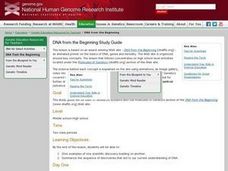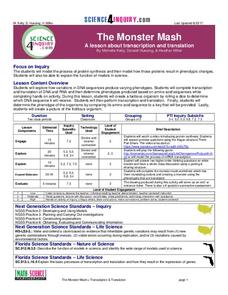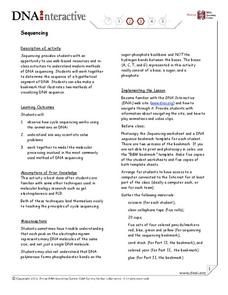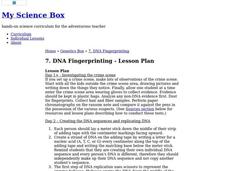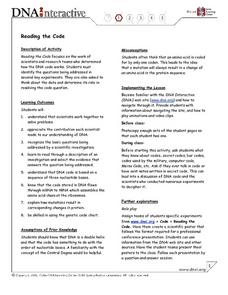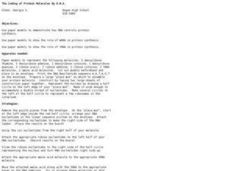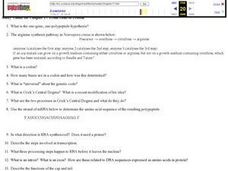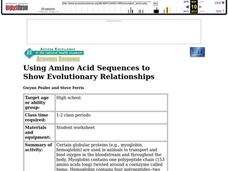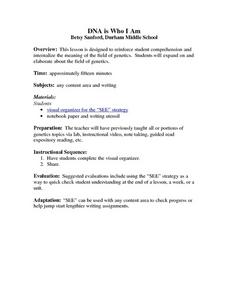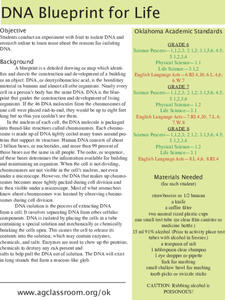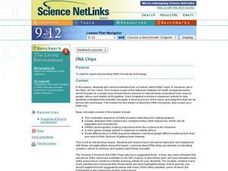Curated OER
DNA from the Beginning Study Guide
Students complete a study guide using a website which is an animated primer on DNA, genes, and heredity. The Web site is organized around key concepts. The web links and study guide are included.
The New York Times
Sequencing the Stages: Understanding H.I.V. Infection at the Molecular Level
How does HIV operate at the molecular level? Pupils discover the progression from a healthy immune cell to one infected with HIV, watch an animation of the HIV life cycle, and finally identify each of the stages with illustrations...
Science 4 Inquiry
The Monster Mash
Young scientists create monsters by applying their knowledge of transcription and translation. They randomly find the DNA, assign it a codon, and build monsters piece by piece.
Curated OER
Sequencing
Students gather information about gene sequencing. In this biology lesson, students use the Internet to access information about gene sequencing, then work in pairs to read and record a gene sequence. Lesson includes extension activities.
Curated OER
The Structure of DNA
Students describe the structure of the double helix, explain how DNA copies itself, and recognize that the sequence of DNA is what makes each individual unique.
Curated OER
DNA Fingerprinting
Students discuss DNA Fingerprinting and gel electrophoresis before participating in a crime solving activity. Students simulate their DNA using adding tape and complete the steps necessary to do a gel electrophoresis. They discuss the...
Curated OER
Macro-DNA: Doing DNA Fingerprinting and Gel Electrophoresis
Students create numbered DNA sequences by taping together the order of the sequence. They count the number of bases in their RFLP's and shade the boxes on their Gel Electrophoresis sheets that represent individual fragments. They...
Curated OER
Sequencing the Cystic Fibrosis Gene: A Simulation
Ninth graders use this activity to simulate the sequencing of gene and to detect the presence of possible genetic defects. They use diagrams that represent bands of nucleotides in order to determine the sequence of a small piece of the...
Curated OER
Discovering DNA Structure
High schoolers work on this paper lab in cooperative groups of four and manipulate nucleotides to discover the structure of DNA. When they have finished the lab, students have created model of DNA that can be hung on the ceiling. High...
Curated OER
DNA Code
Students synthesize information gathered from the web on reading the DNA code. In this upper-level biology lesson, students use an online resource to gain information about DNA codes and then create posters on what they have learned....
Curated OER
The Coding of Protein Molecules by DNA
Students investigate the production of proteins by the DNA. In this protein synthesis lesson plan, students use paper models to explore transcription and translation to make proteins using DNA. Students answer 10 questions to demonstrate...
Curated OER
Discovering DNA Structure
Students work in cooperative groups of four and manipulate paper nucleotides to discover the structure of DNA. They model DNA and sing the DNA song to review concepts. Lyrics to song included in lesson plan.
Curated OER
Comparison of Protein Sequences From Two Samples of Crabmeat Using Gel Electrophoresis As an Introduction To the Biotechnology Lab
Students discover that proteins that are the product of DNA translation are different for different species. They determine that by analyzing their mass and charge they can differentiate between two different species. They use some of...
Curated OER
Genetic Jewels: Building the DNA Model
Students construct segments of DNA to create a piece of jewelry. For this genetics lesson students create a DNA sequence that they turn into something to wear.
Curated OER
DNA and Genetic Expression
Students, in groups, complete a worksheet on DNA transcription and translation. They determine codons for particular amino acids. They attempt to introduce mutations to determine what will happen to the DNA sequence.
Curated OER
Where's the CAT? a DNA Profiling Simulation.
Students explore DNA technology. Students participate in a simulation to perform at the basic steps of a DNA profile. They observe copies of DNA sequences, construct DNA probes, and discuss outcomes of their experiment.
Curated OER
Using Amino Acid Sequences to Show Evolutionary Relationships
Junior biologists compare the amino acid sequences from fragments of five different globin molecules. They count the letter differences between each species pair. They construct a graphic representation of the evolutionary relationships...
Towson University
Case of the Crown Jewels
Can your biology class crack the Case of the Crown Jewels? Junior forensics experts try their hands at DNA restriction analysis in an exciting lab activity. The lesson introduces the concept of restriction analysis, teaches pipetting and...
Curated OER
From Gene to Protein Study Guide
In this biology worksheet, students review and answer different questions based upon the molecules of DNA and RNA. They look at the specific protein order of the DNA strand and its synthesis.
Curated OER
Using Amino Acid Sequences to Show Evolutionary Relationships
Compare protein fragments, count amino acids, and use the information to explore common ancestry. The resource mentions a student worksheet, however, a separate printable worksheet is not provided. The exercises are written into the...
Curated OER
DNA Blueprint for Life
Did you know that meat tenderizers contain DNA cutting enzimes? Did you know that you can isolate your own DNA? Or the DNA of fruit? Explore with your learners the DNA world with a series of experiments using readily available materials...
Curated OER
DNA Replication, Transcription, and Translation
Students apply the rules of complementary base pairing to finding the complementary sequence to a given strand of DNA. After extensive researching, the also find the amino acid sequence encoded by a given strand of DNA.
Curated OER
DNA Chips
High schoolers discover what they need to know about DNA chips. They extend this knowledge to analyze gene expression data to diagnose two kinds of leukemia.
